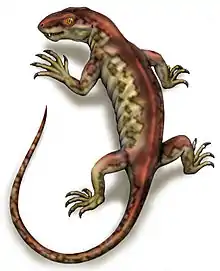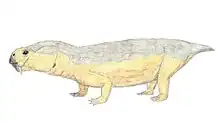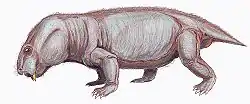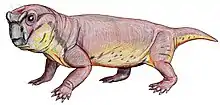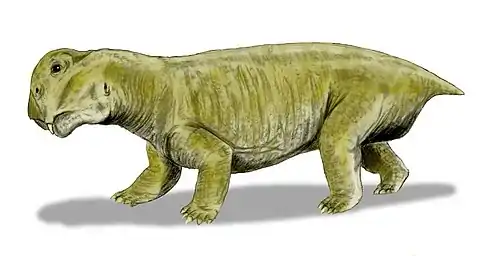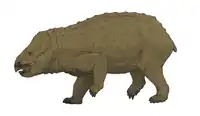Ischigualastia
Ischigualastia is an extinct genus of large dicynodont therapsids that lived during the Late Carnian age and the Early Norian age of the Late Triassic Period. The genus was found in and named after the Ischigualasto Formation (Cancha de Bochas Member) of the Ischigualasto-Villa Unión Basin in northwestern Argentina. It has been placed in the family Stahleckeriidae.[1]
| Ischigualastia | |
|---|---|
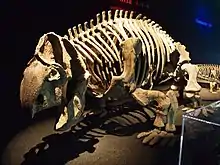 | |
| Mounted skeleton of Ischigualastia jenseni | |
| Scientific classification | |
| Domain: | Eukaryota |
| Kingdom: | Animalia |
| Phylum: | Chordata |
| Clade: | Synapsida |
| Clade: | Therapsida |
| Suborder: | †Anomodontia |
| Clade: | †Dicynodontia |
| Family: | †Stahleckeriidae |
| Subfamily: | †Stahleckeriinae |
| Genus: | †Ischigualastia Cox 1962 |
| Type species | |
| †Ischigualastia jenseni Cox, 1962 | |
Description
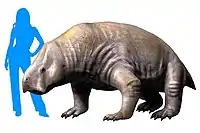
The genus is described as an enormous dicynodont, with a short, high skull, and lacking tusks.[2] It is regarded as larger as its later, more famous relative Placerias, which weighed over 2 tonnes (2,000 kg).
Paleoecology
It was a large quadrupedal herbivore, most common at the base of the Ischigualasto Formation. It was a common member of the local fauna, although not as abundant as the medium-sized herbivores Hyperodapedon and Exaeretodon. The only danger to such a huge animal was the almost equally large carnivorous pseudosuchian Saurosuchus and perhaps the predatory dinosaur Herrerasaurus, which shared the same environment. It was the second largest dicynodont after the gigantic Lisowicia.
See also
References
- Carroll, Robert L. (1988). Vertebrate Paleontology and Evolution. W.H. Freeman and Company. ISBN 0-7167-1822-7.
- Kazlev, M.A., White, A.T. (2004-02-01). "Therapsida: Neotherapsida: Dicynodontia". Palaeos. Retrieved 1 November 2014.
{{cite web}}: CS1 maint: multiple names: authors list (link)
